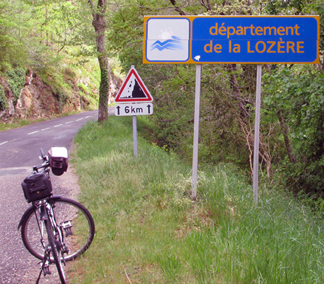
Walter J. Moore sets out on a 70-kilometer (43-mile) ride at the start of an 18-day self-guided cycling tour along the Gorges of the Tarn and the Jonte in southwestern France. But then the rain comes, followed by vultures.
By Walter J. Moore
It’s an astonishing sight: a 2.46 kilometer (1.53 miles) long, stay-cable bridge supported by seven pillars that look like tuning forks. At the top, each fork of a pillar has enough room for a tennis court. The bridge tops out at 343 meters (1,125 feet) above the Tarn River.
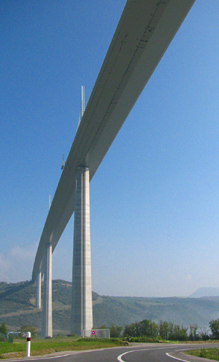
Until the bridge opened, in December 2007, all that traffic would have passed through the town of Millau. I’d taken a restful coffee break at a café in the center of town, a pre-cycling pause that would likely have been much less peaceful if it involved watching a slow parade of long-haul trucks.
Geography
Earlier the prior day I’d set out on what I expected to be a 70.3 kilometer (43½ mile) ride on Day 1 of an 18-day self-guided cycling tour in the Aveyron, Lozère and Lot departments of southwestern France.
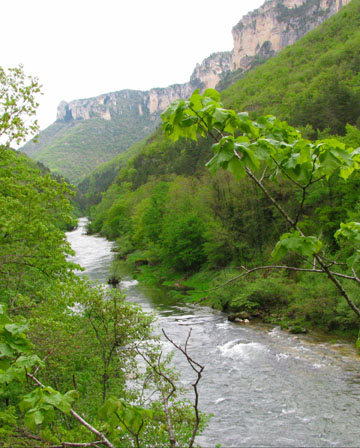
The resulting gorges, often 600 meters (1,970 feet) from the river up to the tops of the cliffs, split a series of plateaus known as causses in central and southern France: Causse Sauveterre (north), Causse Méjean (northeast) and Causse Noir.
These sparsely populated plateaus are the domain of sheep and shepherds. The sustaining and commercial products are wool, meat, and milk used in local cheeses, including the lesser known pélardon and the greater known Roquefort, the latter made in a village of the same name 10 miles southwest of Millau.
The gorges involve about 330 feet of ascent over 22 miles of bicycling. Once up on a causse, the terrain is rolling and also pleasant to bicycle. It was the change from gorge to causse that was my challenge on this trip.
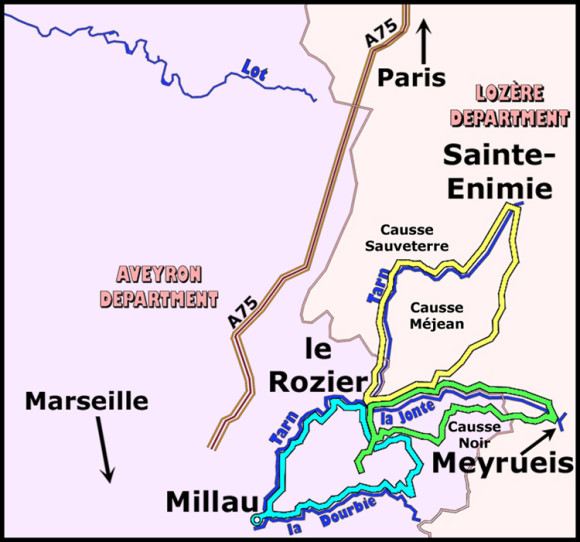
Tarn Gorge and Causse Méjean
This was my sixth cycling trip in France. As on previous trips, I began by hauling my bike out of the rented micro-van and mounted my cycling computer/altimeter.
I was starting out from the Grand Hôtel de la Muse, a few hundred yards northeast of the center of Le Rozier. From my third floor balcony on the first cool morning I saw large, circling birds high above me close to the cliff tops and just below the clouds. After a decent breakfast, I walked out onto the lawn along the Tarn and watched a skilled fly-fisherman casting across the river.
I was wearing three layers of cycling shirts, a high visibility jacket, shorts, leg warmers, socks and shoes. Surely the moist, 52°F air did not cause me to think of waiting for another day. This was cool for May in southwest France and much cooler weather than I would choose to ride in at home in Florida. Aside from the temperature, though, there was nothing else about the weather to give me pause.
Off I rode north on D907 with the Tarn on my right and high cliffs on both sides of the river. Best of all for cycling, the road was paved and automobile traffic was light. My lunch destination was Sainte Enimie, 22 miles (35 kilometers) upriver. I set out hoping that the overcast would burn off during the morning.
The ride to Ste-Enimie revealed the power of a river over time. Steep cliffs rise 1475-1650 feet to the Causse Sauveterre on my left and the Causse Méjean on my right. Humans have attempted to alter small portions along the cliffs and river for over 5,000 years. I had read that the Ferrière tribe established Dolmens on the plateau, and I noticed evidence of several abandoned lignite mines hand tunneled into the cliffs.
There are three villages with restaurants along this stretch to Ste-Enimie: Les Vignes, La Malène and Saint-Chély-du-Tarn. Beyond the paved road there is rock and water. The views along the river often inspired me to stop to take some pictures. I spotted a first-time group of two dozen children learning to pilot canoes down the river. They were clearly novices. Their screams of anxiety and fun while avoiding cold water, rocks and each other could be heard over the next two miles as I pedaled on.
Saint Enimie
Arriving in Sainte Enimie at lunchtime, I easily spotted a good place to eat. There are a number of choices in the center of the village along riverfront. My favorite choice early in a multi-week trip is pizza with a load of carbohydrates. Alone in the pizzeria, a beer and large pizza in front of me, Willie Nelson and Loretta Lynn serenaded the room from the sound system with “God Bless America.” Could the moment get any better than this?
Enimie, after whom the village was named, was a seventh century Merovingian princess, daughter of King Clothar II and sister of King Dagobert I. When the beautiful Enimie reached the age to be married, Clothar brought several eligible nobles to meet her. Wanting to continue her good works nursing lepers, she refused them all.
Legend has it that Enimie implored divine intervention to get out of marriage. She became afflicted with leprosy. This solved the marriage problem but then she wanted to be cured. An angel guided her up the Tarn River to Burlats (now the village of Sainte Enimie) and a curing water source. She bathed once and was miraculously cured. She then traveled out of Burlats but the illness came back. Revisiting the water source, she was again cured. Again she left, and again she relapsed and came back to the curing source. Ultimately she decided to stay and live in a cave. She had many confrontations in the cave with a devil-type named Drac. Surviving these encounters, she established a convent in the village where she lived out her days treating lepers.
After lunch, I sat outside thinking little about the light sprinkles and much more about getting out of the gorge and over the causse. I looked south across the river and up. The temperature was still cool and wet clouds sat below the tops of the cliffs. It was only my first day of cycling—I wasn’t going to spoil it by heading directly back down the Tarn to my warm hotel.
Cycling in the rain

Riding cross the river, I climbed the 1,325 feet to the Causse Méjean and the initial summit of Col de Coperlac, where the sprinkles turned into cold rain. During the climb, I didn’t notice the cold so much as being soaked through and through.
After the Coperlac the route drops 230 feet, I started to feel cold and thought I was in trouble. Trouble was wind-chill and my clothing soaked through to my skin, along with knowing that the way to the hotel would be even colder whether I continued as originally planned or turned back. Continuing forward after that descent, there was a 540-foot climb, which warmed me some without drying me in the least.
Next was the final 1,900-foot descent into La Jonte Gorge. That road is no more than 13 feet wide most of the way with all kinds of switchbacks, shear drop-offs and descents up to 8%. I was shaking with cold during the last 200 yards of descent and had difficulty controlling the bike.
About 4 p.m., I pulled over at the lone restaurant that appeared just as I rode onto the gorge road.
I asked the proprietress of Chez Armand if I could drain some on the porch. “Non,” she said and pulled me into the empty main room, sitting me in front of glowing fireplace. “Café, monsieur?” she asked. “Oui.” I replied. “Petit?” “Non. Grand!” I held the large cup tightly in my hands and sipped for ten minutes until my hands stopped shaking.
Somewhat restored I then cycled the final three miles to the hotel in the rain.
Vultures Sanctuary
Day 2: The sky was crystal clear in the morning. Speaking with the waiter at breakfast I had mentioned that I planned to cycle across the Causse Noir to the village of Meyruies during the day.
Not wanting to discourage a guest, he reluctantly let me know that snow had fallen on the high plateau overnight, but maybe it would melt during the afternoon. Of course, the melt would freeze during the late afternoon. That was serious. Along with lightning and snow, ice is no friend to the cyclist. I had to implement plan B.
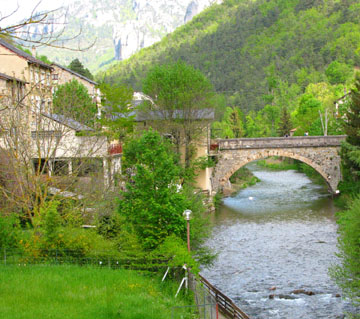
I wanted to know more about those big soaring birds as well as return to the restaurant that had provided me shelter the previous afternoon so as to thank the proprietress. An inquiry at the front desk sent me cycling up the Jonte Gorge to both the Belvédère des Vautours (Vultures Viewpoint) and Chez Armand.
First to the viewpoint. There is a parking area a little over 2 miles east of la Rozier along the Jonte on the river side of the road. South across the river is the Cirque de Madasse, a loop carved by nature into the Corniche du Causse Noir. Way up in the gorge near the top of the cliffs sitting on a ledge at least 150 yards above me was a large dark tan bird with a white collar. A local birdwatcher let me use her binoculars and told me I was looking at a Griffon Vulture (Gyps fulvus).
A half-hour later we also spotted a couple of Black Vultures (Aegypius monachus) and the smaller Egyptian Vultures (Neophron percnopterus). The Blacks have a wingspan of 9 feet, the Griffons’ typical wingspan is 8¼ feet, and the Egyptian has a wingspan exceeding 7 feet.
Vultures have the unwarranted reputation for snatching lambs, but vultures really feed on carrion. The French government passed a law, perhaps in the eighteenth century, that all carcasses (not slaughtered for food) must be buried. Later the government encouraged shepherds to poison some carcasses left out for vultures. As a result the vulture population starved or was poisoned, and vultures became extremely rare in France during the eighteenth and nineteenth centuries. (An unintended consequence of burying carcasses was that ground water became contaminated.)
In 1970, Michel Terrasse and some fellow bird-lovers started reintroducing Black Vultures into the Jonte Gorge just above that viewpoint. But the program was halted for two decades as they learned how to familiarize the birds with the area. Meanwhile, Mr. Terrasse convinced local shepherds, with government permission, to place sheep carcasses on wooden stands. Reintroduction started again in 1992. Within a decade the population of Blacks was 60 and self-sustaining.
Previously, starting in 1981, the same bird-lovers had introduced twelve Griffon Vultures with the first chick from a breeding pair taking flight in 1982. No further additions have been necessary since 1986. By 2003 the Griffon population had grown to 400. The birds travel as far as Switzerland, The Netherlands, Latvia and Senegal, returning to the Jonte Gorge to nest and reproduce. In the mid 1980s, the Egyptian Vulture also returned to the Jonte Gorge, perhaps following the Griffon Vulture.
Vultures from a single colony share the task of searching for food over their territory. Griffon Vultures are able to distinguish a sheep at rest from a dead sheep at more than 300 meters. Within minutes of a Griffon reaching the carcass, ten to fifteen more turn up for the spoils, hastily eating the more tender parts. They leave immediately afterwards, making way for the more imposing Black Vultures that tackle the tougher and stringer bits of the dead animal. Finally, the Egyptian Vultures arrive, making do with leftovers. Within a quarter of an hour, a whole carcass has been converted into a clean skeleton.
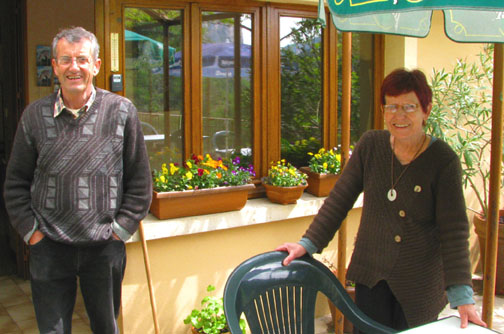
My vulture education much improved, I rode on to Chez Armand where Gisèle Costecalde had provided coffee and shelter the previous day. I thanked her for her kindness, and she and her husband allowed me to take a picture of them as a memento.
After another half hour cycling up the gorge, I returned to Le Rozier village where I ended the afternoon slowly cycling around the village. I stopped to relax in the sun in a café. I listened to the river and hoped the weather would be kind during the next sixteen days.
Later in the afternoon I stopped again for an aperitif and found myself contemplating what I would choose for dinner; lamb might be nice.
Then I got back on my bike one last time for the day and a slow ride to the hotel.
© Walter Judson Moore, 2011
Walter Judson Moore is the author of four cycling guidebooks and three companion queue sheets guides for France. His guide “Lot Vineyards to Tarn Gorges: A Bicycle Your France Guidebook” includes the area covered by this article, as does his “Lot Vineyards to Tarn Gorges Queue Sheets.” His work is available Lulu, Amazon and other online booksellers, as well as directly (and personally signed) from the author, who may be reached at bicyclemoore@tampabay.rr.com.
Hotel Doussiere is a 2-star hotel with restaurant in the center of Le Rozier.


Walter is a goldmine for useful information about cycling in different parts of France. Great article Walter. What a trip!
Now that’s an article to pique my interest in another area of France!
I’ve used Moore’s books for Burgundy and they proved a great resource. Now it looks like I’ll have to go to the Tarn. 🙂
Great article Walter! Difficult to read over the cobblestone though…
Bonjour Linda,
Sorry about the cobblestone. That happens on certain (hopefully not too many) computer settings and is apparently happening with yours. If you get a chance, check the article out on another computer and it should be equally great as well as easy to read.
Gary
I followed Walter’s guide through Burgandy and now have added the Tarn river agenda to my list of must dos. Well done Walter!
Ed
Fascinating article, Walter. Whets my appetite for another cycle trip to France. And thanks for the details on the vultures.
Now my daughter and I know where to really test our newly recovered capability of riding bicycle especially when you are navigated by so professionally developed guide brochures. Hope to meet the author somewhere on the roads of France. Special thanks for wonderful photos.
WHAT A TRIP AND EDUCATIONAL AS WELL LOOK FORWARD TO MORE ADVENTURES.
Always great to follow your adventures.
Great article. This helps in trip planning!!! Keep up the good work!
What a communicator!!! Just reading this makes me want to go….
The author makes one want to ride along the Tarn, see the causse and the vultures, take a little time in the French villages and enjoy some French wine and cheese. Excellent adventure.
Beautiful article about your cycling adventure. Look forward to the next one.
I have always dreamed to travel to South France. Now having read the article I am willing to hurry up with the travel!
Great article. Enjoyed the stories.